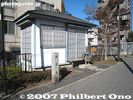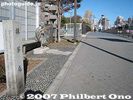 Image search results - "matsuo" Image search results - "matsuo" |

Site of Basho-an Hut, now a small garden with a statue of Basho overlooking the Sumida River. 芭蕉庵史跡展望庭園
|
|

Site of Basho-an Hut at the mouth of the Onagigawa River where it meets the Sumida River.
|
|

Statue of Basho. A short walk away is the Basho Memorial Museum.
|
|

Statue of Basho. Kiyosubashi Bridge and Sumida River in the background.
|
|

Statue of Matsuo Basho, haiku poet. Koto-ku, Tokyo
|
|

Statue of Matsuo Basho, haiku poet. Koto-ku, Tokyo
|
|
|

Haiku poem by Basho displayed along Sumida River
|
|

Near the southern corner of Kiyosumi Garden is the site of the Saito-an Hut where Basho departed for his Okuno Hosomichi trip to the Tohoku region. 採茶庵跡
|
|

Site of Saito-an Hut which was a 2nd house of Sugiyama Sanpu, one of Basho's disciples. 採茶庵跡
|
|

There is a makeshift hut and a statue of Basho sitting. 採茶庵跡
|
|

Statue of Basho sitting at the site of Saito-an house. 採茶庵跡
|
|

Statue of Basho sitting at the site of Saito-an house before departing for the Tohoku region. 採茶庵跡
|
|

Statue of Matsuo Basho.
|
|

What the road looks like now.
|
|

Basho Memorial Museum along the Sumida River. Near Morishita Station on the Toei Shinjuku Line. Address: Tokiwa 1-6-3, Koto-ku, Tokyo. Phone: 03-3631-1448 芭蕉記念館
|
|

Inside Basho Memorial Museum. Open 9:30 am - 5:00 pm.
|
|

Rock excavated in this area.
|
|

Small statue of Basho in Basho Memorial Museum
|
|

Basho Memorial Museum displays a replica of the costume worn by Basho.
|
|

Map of Basho's travels. Also see photos of Ogaki where Basho ended his journey.
|
|

Haiku poem by Basho displayed along Sumida River
|
|

Iga-Ueno's Ueno Park includes this beautiful building called the Haisei-den (俳聖殿), a hall dedicated to Haiku poet Matsuo Basho who was from Iga-Ueno.
|
|

A short walk from Iga-Ueno Castle and almost next to the ninja house, the Haisei-den was built in 1942 to mark the 300th anniversary of Basho's birth.
|
|

The building was designed by architect Ito Chota (1867-1954) (伊東 忠太) who designed numerous shrine and temple buildings in the 1920s and '30s, including Tsukiji Hongwanji temple in Tokyo.
|
|

The Haisei-den was designed to look like Basho in travel clothing. The top roof resembles a hat, and the lower roof resembles his straw raincoat. Cherry blossoms were in bloom.
|
|
|

Haisei-den and wisteria in bloom. The Basho Matsuri Festival is a poetry reading held here on Oct. 12.
|
|

Inside the Haisei-den is a ceramic statue of Basho.
|
|

Iga-yaki ceramic statue of Basho inside the Haisei-den.
|
|

A short walk from Ueno Park is the Basho Oseika (芭蕉翁生家) or Basho's childhood home. Iga is the birthplace of Matsuo Basho (1644-1694), and the house where he grew up in still stands.
|
|

The house is open to the public as a tourist attraction (admission 300 yen). The house was rebuilt after it being damaged by a large earthquake in 1854.
|
|

Room inside Basho's childhood home.
|
|
|

Small door to the kitchen. People must have been pretty short then.
|
|

Kitchen area with a well on the left and stoves toward the right.
|
|
|
|

Water well
|
|

Kitchen stoves
|
|
|

Toilets and bath
|
|

Urinal
|
|
|

The back of the house is Basho's study called Chogetsuken (釣月軒) where he wrote the Kai-ooi (貝おほい) series of poems.
|
|

Inside the Chogetsuken study. 釣月軒
|
|

The study is a very simple, yet aesthetic and meditative-looking room.
|
|
|

Statue of Basho at Ueno-shi Station.
|
|
|
|















































